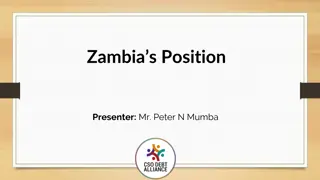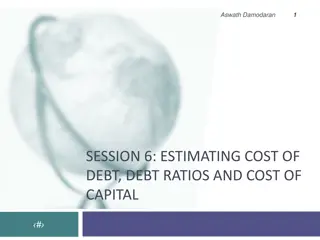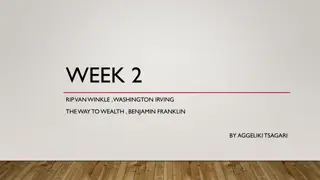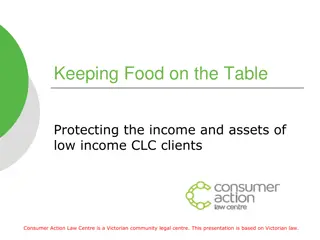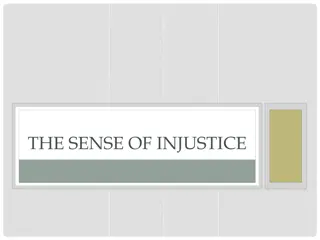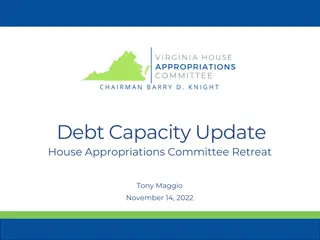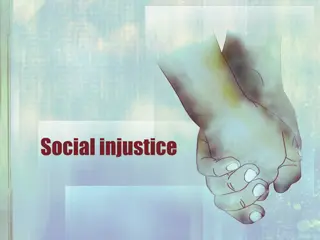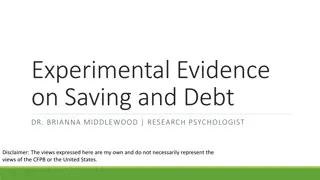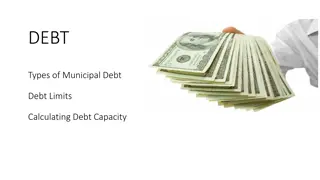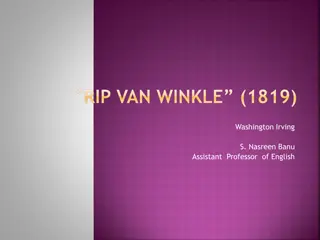Efforts to End Medical Debt Injustice by RIP Medical Debt
RIP Medical Debt is on a mission to eradicate the uniquely American injustice of medical debt. Since 2014, they have abolished over $5.5 billion in debt, impacting over 3 million individuals and families. Through strategic initiatives, RIP raises funds, acquires debt, drives policy change, and raises awareness about the impact of medical debt. They focus on racial equity, public policy advancement, and improving healthcare billing practices to relieve the burden of medical debt on communities.
Download Presentation

Please find below an Image/Link to download the presentation.
The content on the website is provided AS IS for your information and personal use only. It may not be sold, licensed, or shared on other websites without obtaining consent from the author.If you encounter any issues during the download, it is possible that the publisher has removed the file from their server.
You are allowed to download the files provided on this website for personal or commercial use, subject to the condition that they are used lawfully. All files are the property of their respective owners.
The content on the website is provided AS IS for your information and personal use only. It may not be sold, licensed, or shared on other websites without obtaining consent from the author.
E N D
Presentation Transcript
RIP Medical Debts Mission Medical debt is a uniquely American injustice. It prevents millions from achieving financial stability and subjects them to emotional anguish. Our mission is to end medical debt and be: A source of justice in an unjust healthcare finance system A unique solution for patient-centered healthcare providers A moral force for systemic change 2
How RIP Carries Out Its Mission We bring benefits to patients, healthcare providers, and communities by: Raising donor funds Acquiring and abolishing medical debt for people in financial hardship Seeking to change hospital and health system policies and behaviors Raising awareness about the problem Conducting and publishing research Engaging in public policy 3
Debt Abolished, People Helped Since Inception (2014) $5,567,035,572 FACE VALUE DEBT ABOLISHED 3,154,196 $1,606,448,937 PEOPLE AND FAMILIES IMPACTED DEBT ABOLISHED IN 2021 ALONE
Strategic Plan Initiatives Initiatives Goals a) b) c) d) e) f) Grow strategic debt acquisition partnerships Invest in data and systems Hone policies and processes to match donations and debt Update RIP s abolishment criteria Ensure impact of abolishment work Grow and diversify funding Increase scale, efficiency, and efficacy of RIP s debt abolishment work a) b) c) d) Partner with organizations and individuals advancing public policy Generate more data useful to public policy efforts Elevate RIP data, insights, & beneficiaries stories Work with hospitals to improve billing policies Influence hospital & public policy to relieve medical debt a) b) c) d) Analyze demographics of RIP s beneficiaries Adjust debt abolishment efforts to ensure racial equity outcomes Build RIP s fluency in issues of racial equity Grow representation of diverse perspectives in RIP s staff and Board Strengthen RIP s commitment to racial and social equity a) b) Clarify our brand identity as a public-facing organization Externally communicate RIP s updated strategy and identity Communicate RIP s updated identity 5
Impact of Medical Debt Social Determinant of Health Delay or Forego Care Mental Health Credit Score / Access Leading Cause of Bankruptcy 6
JAMA Study: Medical Debt in US 17.8% of people in US have medical debt in collections Pre-Pandemic Highest among low-income Zip Codes in the south Concentrated in states that did not expand Medicaid 7
RIP Medical Debt Data From Healthcare Organization: From TransUnion Healthcare: Patient/Guarantor Address Estimated Federal Poverty Level (FPL) Date of Service Estimated Household Income Balance Owed Insurance Status Bankruptcy Status Age Other Household Characteristics Gender Race (future data point) 8
RIPs CurrentDebt Abolishment Criteria Low income: Patient (or guarantor) household income between 0-200% of current Federal Poverty Guidelines, or Medical debt burden: The medical debt being assessed represents 5% or more of annual household income. 9
Analysis Provided to Healthcare Organizations Accounts that qualify for RIP s program: Face value, number of accounts, number of individuals Estimated Fair Market Value Characteristics of patients who did not receive financial assistance: Qualified based on RIP s medical debt burden criterion Ineligible due to FAP restrictions (e.g., residency, assets) Never applied and never assessed for presumptive charity Experienced financial hardship after the window of opportunity to apply closed 10
Analysis Provided to Healthcare Organizations Feedback on policies and procedures: Compliance with federal and state laws and regulations Other problems with policies and procedures, e.g.: Policies invisible Excessive documentation requirements Applications taken only after bills sent to patients FAP Plain Language Summary omits important details Policies written for staff and not for patients Unnecessarily aggressive collections actions Problems with presumptive eligibility process (e.g., not notifying patients) 11
Some Policy Solutions Limitations of Surprise Billing Act Patient Education Insuffient Expand Government Supported Coverage Medicaid Medicare Premium subsidies Low deductibles Regulate Debt Collection Practices and Charity Care Policies Financial assistance eligibility criteria Allowed (and disallowed) medical debt collections actions 12
RIP Model Research Study: The Impacts of Medical Debt Relief Analyzing what happens after medical debt is sent to collections Credit limits Interest rates Financial Distress Estimating effects of medical debt abolishment Credit scores Access to essential credit products and ability to borrow Physical and Mental Health Randomized Control Trial (Survey Instrument) Clinically validated mental health screeners for depression and anxiety Whether respondent has forgone basic necessities due to medical debt Whether respondent has skipped filling prescriptions Forgoing future health care 13
Impact A study of RIP's program conducted by researchers at MIT, University of Chicago, UCLA, and UC-Berkeley tracks the economic and health outcomes of medical debt relief. Initial findings suggest removing the burden of medical debt engenders stability in other crucial areas of people s lives their finances, health, home, family, or career.
Contact Us: www.ripmedicaldebt.org Allison.Sesso@ripmedicaldebt.org Keith.Hearle@ripmedicaldebt.org 15
Appendix The following slides offer additional background but are not part of the formal presentation. These were developed as part of RIP Medical Debt s recent strategic planning process and helped to inform our thinking and adopted approach. 16
Income, insurance status, and health status are the biggest determinants of medical debt Income 37% of those with incomes below $50K/year have medical debt, compared to 26% of those with incomes from $50k-$100k, and only 14% in the highest income category Health status People with disabilities, self-reported health issues, and people with chronic conditions are significantly more likely to have medical debt Insurance status 53% of people without health insurance have medical debt Source: KFF https://www.kff.org/report-section/the-burden-of-medical-debt-section- 1-who-has-medical-bill-problems-and-what-are-the-contributing-factors/ 17
Black, Indigenous, and Hispanic people are worse off than White people with regard to the key predictors of medical debt Key predictor of medical debt Detail In 2019, White people s median household income was $70K, compared to $44K for Black people, $45K for American Indian and Alaska Native people, $56K for Hispanic people, and $94K for Asian people(1) Income Black, Indigenous, and Hispanic people fare worse than White people across many health status indicators(3) Health status Black, Indigenous, and Hispanic people are more likely to be uninsured than White people(4) Insurance status Sources: (1)US Census ACS data data.census.gov (2)2019 Cleveland Federal Reserve Bank report clevelandfed.org/newsroom-and-events/publications/economic- commentary/2019-economic-commentaries/ec-201903-what-is-behind-the-persistence-of-the-racial-wealth-gap.aspx (3)Kaiser Family Foundation report on health disparities kff.org/racial-equity-and-health-policy/issue-brief/disparities-in- health-and-health-care-5-key-question-and-answers (4)Kaiser Family Foundation report on health insurance status of people pre and post ACA kff.org/racial-equity-and- health-policy/issue-brief/changes-in-health-coverage-by-race-and-ethnicity-since-the-aca-2010-2018 18
Medical debt leads to other financial challenges Percent of people with trouble paying medical bills who say they or someone in their household has done each of the following in the past 12 months in order to pay medical bills: Used up all or most of savings 59% Increased credit card debt 34% Taken money out of retirement, college, or other long-term savings accounts 26% Taken out another kind of loan 15% Medical debt is the leading cause of bankruptcy and the primary reason Americans cite for not being able to buy or rent a home Borrowed from a payday lender 13% Sources: Kaiser Family Foundation / New York Times Medical Bills Survey (conducted August 28- September 28, 2015) https://www.kff.org/report-section/the-burden-of-medical-debt-introduction/ Zillow report via Bloomberg news bloomberg.com/news/articles/2019-09-30/medical-debt-is-no- 1-dealbreaker-for-u-s-housing-zillow-says American Journal of Public Health via CNBC cnbc.com/2019/02/11/this-is-the-real-reason-most- americans-file-for-bankruptcy.html 19
Medical debt creates significant quality-of-life issues Overall, how much of an impact have these medical bills had on you and your family? No real impact, 7% A major impact, 44% A minor impact, 47% Percent who say they or someone in their household has done each of the following in the past 12 months in order to pay medical bills: Put off vacations or other major household Put off vacations or other major household purchases Cut back on food, clothing, or basic household 72% purchases Cut back on food, clothing, or basic household items 70% items Taken an extra job or worked more hours 41% Borrowed money from friends or family 37% Changed your living situation 17% Source: Kaiser Family Foundation / New York Times Medical Bills Survey (conducted August 28-September 28, 2015) https://www.kff.org/report-section/the-burden-of-medical-debt-introduction/ 20
About 2/3 of people with medical bill problems attribute them to one-time medical expenses Among those who had problems paying household medical bills in the past 12 months, which of the following comes closer to describing the medical bills you ve had problems paying? Bills that have built up over time, such as treatment for a chronic illness like diabetes or cancer, 33% Bills for a one-time or short-term medical expense, such as a single hospital stay or treatment for an accident, 66% Don't know / refused to answer, 2% Source: Kaiser Family Foundation / New York Times Medical Bills Survey (conducted August 28-September 28, 2015) https://www.kff.org/report-section/the-burden-of-medical-debt-introduction/ 21
No one illness or injury is responsible for burdensome medical debt The most common illness / injuries that led to medical bills people struggle to pay (noting that respondents could indicate debt due to multiple illnesses / injuries): Teeth / dental 10% Heart disease / heart attack / stroke 8% Arthritis / joint pain / joint problems 8% Cancer / tumors 6% Gastrointenstinal 6% Back / neck problems 6% Respiratory problems 5% Broken bones 5% Vehicle accidents 5% Unspecified accidents 5% Mental health / substance abuse 5% Maternity care 5% Source: Kaiser Family Foundation / New York Times Medical Bills Survey (conducted August 28-September 28, 2015) https://www.kff.org/report-section/the-burden-of-medical-debt-introduction/ 22
Making healthcare costs less onerous has public support across the political spectrum, according to a recent survey % of respondents who somewhat support or strongly support % of Republican respondents who somewhat support or strongly support Survey question 69% 62% Do you support or oppose all hospitals and health care providers to provide free or discounted care to uninsured or self-pay patients who are low income? 68% 55% Do you support or oppose prohibiting hospitals and health care providers to garnish wages, tax refunds, or seize property for people with unpaid medical bills? 69% 63% Do you support or oppose prohibiting hospitals and health care providers from suing low-income patients for unpaid medical bills? Source: September 2020 Data for Progress poll via The Appeal https://theappeal.org/the-lab/policy/how-to-solve-the-medical-debt-crisis/ 23
Policies addressing medical debt through coverage There are a range of benefits for low-income people to receive coverage, each of which can be expanded through public policy, including: Medicaid (the ACA called for expansion of Medicaid to cover more low- income people, but not all states have decided to do so) Charity care governments can set minimum criteria for hospitals to deliver care at free or reduced rates for low-income people Expanded benefits for low- income people Automatically signing patients up for benefits Requiring charity care or Medicaid to be available to people who meet certain criteria does not mean that those people will be signed up some states have passed laws requiring hospitals to check if patients are eligible and enrolled, and to sign them up for whatever benefits they can Universal coverage Single payer health insurance or a public option could ensure that everyone in the US has coverage such that no one would be forced into medical debt Charity care transparency & accountability More patients could be made aware of the benefits they are eligible for Hospitals could be better held accountable for ensuring that patients receive financial assistance they are eligible for Source: Wellspring Summer 2021 interviews with public policy experts 24
Policies addressing medical debt through collections Suing patients over medical debt they can t pay is highly unpopular, but continues to happen in many places Several states (e.g. Maine, Maryland) have passed legislation creating some protections in this area Consumer protections around lawsuits, garnishments, and liens Eliminating medical debt from credit reports Removing medical debt from credit reports could in theory improve people s ability to secure credit and reduce the burden of medical debt without undermining the usefulness of credit scores Alternative dispute resolution Some hospitals and court systems are piloting programs where hospitals are required to meet with a patient and mediator before filing a lawsuit Requiring payment plan options Not all hospitals are required to offer patients payment plans for medical bills they are unable to pay, but doing so can increase collections and patient well-being Prohibiting collecting on invalid debt Debt is often still collected on even if the charge was incorrect, was already paid, or expired Disallowing hospitals from selling debt can keep some predatory actors from entering the medical debt space Prohibiting selling debt Source: Wellspring interviews with national and state-level public policy experts, July 2021 25





